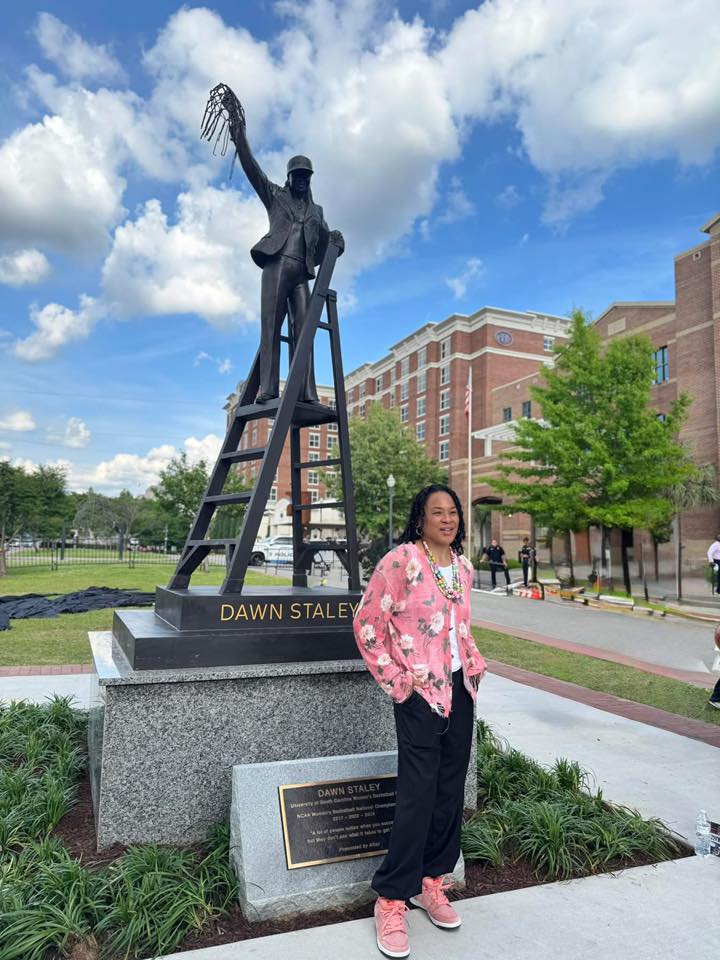
Monumental Moment: South Carolina Honors a Living Legend With Jaw-Dropping Statue to Recognize Staley’s Historic Impact and Achievements
In the realm of sports, few figures have garnered the level of respect, admiration, and love that Dawn Staley has earned. A living legend, Staley has transcended the basketball court to become a beacon of inspiration, empowerment, and success. When South Carolina unveiled a statue to honor Staley’s remarkable achievements, it was not just a tribute to a basketball coach but a powerful statement about what she represents: excellence, resilience, leadership, and groundbreaking contributions to women’s sports. The unveiling of her statue stands as a monumental moment in sports history, one that not only recognizes her historical impact but also solidifies her place as an iconic figure in both college basketball and the broader landscape of American sports.
Before delving into the statue and what it symbolizes, it is essential to understand who Dawn Staley is and the profound impact she has had on the world of sports. Born in 1970 in Philadelphia, Pennsylvania, Staley’s journey to greatness was marked by both extraordinary talent and an unyielding determination to overcome challenges. A standout player in high school and later at the University of Virginia, Staley’s prowess on the court earned her recognition as one of the most skilled and dynamic point guards in the history of women’s college basketball. She led her college team to the NCAA Final Four in 1991 and was named to the prestigious NCAA All-American team multiple times.
Staley’s professional career saw her play in both the American Basketball League (ABL) and the Women’s National Basketball Association (WNBA). Her ability to excel at the highest levels of the sport was evident throughout her playing career, but perhaps even more remarkable was her transition to coaching after retiring from the game. The success Staley has found as the head coach of the University of South Carolina Gamecocks women’s basketball team is nothing short of extraordinary.
Staley’s coaching tenure at South Carolina has been marked by unprecedented success and a deep commitment to shaping the next generation of female athletes. When Staley took the reins in 2008, the Gamecocks were a program with potential but far from the powerhouse they would become under her leadership. Over the course of more than a decade, Staley transformed the team into a dominant force in women’s college basketball. Her passion for the game, combined with a unique coaching style that emphasizes both individual growth and team cohesion, led South Carolina to multiple SEC (Southeastern Conference) titles, NCAA tournament appearances, and, most notably, national championships.
Staley’s ability to recruit top-tier talent has been central to her success. Under her leadership, South Carolina attracted some of the best and brightest players in the country. Most notably, players like A’ja Wilson, who went on to be a standout in the WNBA, flourished under Staley’s guidance. Wilson’s success at both the collegiate and professional levels is a testament to the caliber of coaching she received under Staley’s leadership. In 2017, Staley led the Gamecocks to their first-ever NCAA Women’s Basketball Championship, an achievement that solidified her legacy as one of the best coaches in the sport. Her reputation continued to grow, and in 2022, Staley’s Gamecocks secured another NCAA championship, further cementing her status as one of the most successful and innovative coaches in women’s sports.
The unveiling of the statue in Staley’s honor was not just about recognizing her athletic and coaching accomplishments but also about acknowledging her role in breaking barriers for women in sports. The statue stands tall in front of Colonial Life Arena, the home of the Gamecocks. Crafted by the renowned sculptor, the statue captures Staley in a powerful pose, exuding confidence and strength, much like the way she has carried herself throughout her career. The pose was carefully chosen to reflect Staley’s approach to coaching and leadership: poised, dynamic, and unwavering.
The decision to honor Staley with a statue at this point in her career speaks to the immense impact she has had, not just on South Carolina’s athletic program, but on the culture of women’s sports as a whole. The statue is a testament to her achievements on the court, as well as her advocacy for gender equality, social justice, and empowering young women to pursue their dreams regardless of the obstacles they face. The statue represents a culmination of her work, and it speaks to her role as a trailblazer for women athletes and coaches everywhere.
While Staley’s basketball accomplishments are undeniable, perhaps even more important has been her role in breaking down barriers for women in sports. Throughout her career, Staley has been a fierce advocate for women’s equality in athletics, fighting for equal opportunities, fair pay, and visibility for female athletes. Her leadership extends beyond the basketball court and into the realm of social justice, where she has used her platform to speak out on issues of racial and gender inequality.
As a player, Staley was one of the first women to have her own signature basketball shoe, a testament to her marketability and influence within the sport. As a coach, Staley has continued to shatter expectations, demonstrating that women can succeed at the highest levels of coaching, leadership, and strategy. She has shown that women’s sports deserve the same recognition, respect, and investment as their male counterparts.
By achieving success at South Carolina, Staley has demonstrated that the future of women’s sports is bright, and that it is not only possible for women to lead major athletic programs but to excel in doing so. Her success story is one that many aspiring athletes and coaches, especially women of color, can look to as a source of inspiration. The statue is a physical reminder of how far women’s sports have come, and how much further they can go with continued support, effort, and leadership.
South Carolina’s decision to honor Staley with a statue is also a reflection of the state’s broader commitment to advancing women’s sports. In recent years, the state has taken significant steps to create a more equitable environment for female athletes, and Staley’s success is at the forefront of this movement. The recognition of her achievements with such a monumental gesture underscores the growing recognition of the value of women’s sports in both the public and private sectors.
The state’s commitment to gender equality is evident in the support for the Gamecocks’ basketball program. From the facilities to the resources allocated to the program, South Carolina has consistently shown its dedication to ensuring that women’s sports are given the same opportunities as their male counterparts. By erecting a statue in Staley’s honor, South Carolina has not only acknowledged her individual accomplishments but has also taken a stand for gender equity in the world of athletics.
The statue will serve as an enduring symbol for years to come. It will inspire future generations of athletes, particularly young women, to pursue their dreams with the knowledge that anything is possible. It is a reminder that excellence knows no gender, and that the path to success is open to all who are willing to work hard, overcome challenges, and challenge the status quo.
Staley’s legacy is not just built on the championships and accolades she has achieved but also on the lives she has touched and the barriers she has broken. Her impact extends far beyond the basketball court. She has mentored countless players, helped shape the future of women’s basketball, and provided a model for leadership that will resonate for decades to come.
In a world where statues are often erected for figures who have passed on, the decision to honor a living legend is a powerful and progressive move. It signifies that Staley’s influence is not a thing of the past, but a present and ongoing force within the sports world. The unveiling of her statue is a celebration of not only her career but of the future she continues to shape. It is a statement that women’s achievements, in sports and beyond, should be celebrated and honored while they are still making history.
As the Gamecocks take the court for years to come, Staley’s statue will serve as a constant reminder of her greatness, as well as the tremendous potential of women in sports. The legacy she leaves behind will continue to inspire not only basketball players but anyone who has ever dreamed of making an impact in their chosen field. The monumental moment of her statue’s unveiling is not just a personal victory for Staley; it is a victory for all those who continue to fight for equality, recognition, and opportunity in the world of sports
Dawn Staley’s statue in South Carolina is not simply a tribute to a coach’s success but a celebration of what is possible when passion, perseverance, and leadership are coupled with the desire to break down barriers. It stands as a testament to her extraordinary career and the trailblazing path she has paved for future generations. More than just a piece of art, the statue will be a lasting symbol of what women can achieve in sports, leadership, and life. It marks a monumental moment in history, one that honors the past, celebrates the present, and looks forward to a future of limitless potential.





